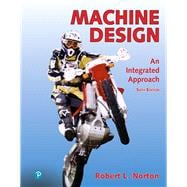An integrated, case-based approach to machine design
Machine Design: An Integrated Approach, 6th Edition presents machine design in an up-to-date and thorough manner with an emphasis on design. Author Robert Norton draws on his 50-plus years of experience in mechanical engineering design, both in industry and as a consultant, as well as 40 of those years as a university instructor in mechanical engineering design.
Written at a level aimed at junior-senior mechanical engineering students, the textbook emphasizes failure theory and analysis as well as the synthesis and design aspects of machine elements. Independent of any particular computer program, the book points out the commonality of the analytical approaches needed to design a wide variety of elements and emphasizes the use of computer-aided engineering as an approach to the design and analysis of these classes of problems.
Personalize learning with Modified Mastering
By combining trusted author content with digital tools developed to engage students and emulate the office-hour experience, Mastering™ personalizes learning and improves results for each student.
You are purchasing an access card only. Before purchasing, check with your instructor to confirm the correct ISBN. Several versions of the MyLab™ and Mastering™ platforms exist for each title, and registrations are not transferable. To register for and use MyLab or Mastering, you may also need a Course ID, which your instructor will provide.
If purchasing or renting from companies other than Pearson, the access codes for the MyLab platform may not be included, may be incorrect, or may be previously redeemed. Check with the seller before completing your purchase.
0135214416 / 9780135214411 MODIFIED MASTERING ENGINEERING WITH PEARSON ETEXT -- ACCESS CARD -- FOR MACHINE DESIGN: AN INTEGRATED APPROACH, 6/e











